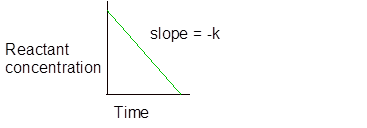
General Chemistry: Principles And Modern Applications Plus Mastering Chemistry With Pearson Etext -- Access Card Package (11th Edition)
11th Edition
ISBN: 9780134097329
Author: Ralph H. Petrucci, F. Geoffrey Herring, Jeffry D. Madura, Carey Bissonnette
Publisher: PEARSON
expand_more
expand_more
format_list_bulleted
Question
Chapter 20, Problem 29E
Interpretation Introduction
Interpretation:
The approximate half-life for the first order reaction is to be determined.
| Set I | Set II | Set III | |||
| Time, s | [A], M | Time, s | [A], M | Time, s | [A], M |
| 0 | 1.00 | 0 | 1.00 | 0 | 1.00 |
| 25 | 0.78 | 25 | 0.75 | 25 | 0.80 |
| 50 | 0.61 | 50 | 0.50 | 50 | 0.67 |
| 75 | 0.47 | 75 | 0.25 | 75 | 0.57 |
| 100 | 0.37 | 100 | 0.00 | 100 | 0.50 |
| 150 | 0.22 | 150 | 0.40 | ||
| 200 | 0.14 | 200 | 0.33 | ||
| 250 | 0.08 | 250 | 0.29 |
Concept introduction:
- Zero-order reaction- for this,
rate of reaction is independent of the concentration.

And the graph of zero order reaction is-

- The first order reaction is the one in which the rate is directly proportional to the concentration of one of the reactant.

And half-life is

Integral rate law for first order reaction is −

and

- The second order reaction is the one in which the rate is directly proportional to the square of the concentration of one of the reactant.

Integral rate law for second order reaction is −

And the graph of second order reaction is-

Expert Solution & Answer
Want to see the full answer?
Check out a sample textbook solution
Students have asked these similar questions
1.3 grams of pottasium iodide is placed in 100 mL of o.11 mol/L lead nitrate solution. At room temperature, lead iodide has a Ksp of 4.4x10^-9. How many moles of precipitate will form?
Q3: Circle the molecules that are optically active:
ДДДД
6. How many peaks would be observed for each of the circled protons in the compounds below? 8 pts
CH3 CH3
ΤΙ
A. H3C-C-C-CH3
I
(₁₁ +1)= 7 H
CI
B. H3C-C-CI
H
(3+1)=4
H
LIH)=2
C.
(CH3CH2-C-OH
H
D.
CH3
Chapter 20 Solutions
General Chemistry: Principles And Modern Applications Plus Mastering Chemistry With Pearson Etext -- Access Card Package (11th Edition)
Ch. 20 - In the reaction 2A+BC+3D , reactant A is found to...Ch. 20 - From Figure 20-2 estimate the rate of reaction at...Ch. 20 - In the reaction A products, [A] is found to be...Ch. 20 - In the reaction A products, at t = 0. [A]= 0.1565...Ch. 20 - In the reaction A products. 4.40 min after the...Ch. 20 - Refer to Experiment 2 of Table 20.3 and to...Ch. 20 - For the reaction A+2BC ,the rate of reaction is...Ch. 20 - If the rate of reaction (20.3) is 5.7104 M s-1 ,...Ch. 20 - In the reaction A(g)B(g)+C(g) , the totalpressure...Ch. 20 - At 65C , the half-life for the first-order...
Ch. 20 - The initial rate of the reaction A+BC+D is...Ch. 20 - For the reaction A+BC+D , the following initial...Ch. 20 - Prob. 13ECh. 20 - The following data are obtained for the initial...Ch. 20 - One of the following statements is true and the...Ch. 20 - One of the following statements true and the other...Ch. 20 - The first-order reaction A products has t1/2=180...Ch. 20 - The reaction A products is first order in A....Ch. 20 - The reaction A products is first order A. a. If...Ch. 20 - In the first-order reaction A products, [A] =...Ch. 20 - In the first-order reaction A products, it found...Ch. 20 - The half-life of me radioactive isotope...Ch. 20 - Acetoacetic acid, CH2COOH2COOH , a reagent in...Ch. 20 - The following first-order reaction occurs in...Ch. 20 - For the reaction A- products, the following data...Ch. 20 - The decomposition of dimethyl ether at 504C is (...Ch. 20 - [Hint: There are several of arrivivg at answer for...Ch. 20 - [Hint: There are several of arrivivg at answer for...Ch. 20 - Prob. 29ECh. 20 - Prob. 30ECh. 20 - Prob. 31ECh. 20 - Prob. 32ECh. 20 - [Hint: There are several of arrivivg at answer for...Ch. 20 - [Hint: There are several ways of arrivivig at...Ch. 20 - Prob. 35ECh. 20 - Prob. 36ECh. 20 - For the reaction A products, the following data...Ch. 20 - Prob. 38ECh. 20 - For the reaction A products, the data tabulated...Ch. 20 - For the reaction A2B+C , the following data are...Ch. 20 - In three different experiments, the following...Ch. 20 - Ammonia decomposes on the surface of a hot...Ch. 20 - Prob. 43ECh. 20 - Consider three hypothetical reactions A — products...Ch. 20 - Prob. 45ECh. 20 - If even tiny sped is introduced into a mixture of...Ch. 20 - For me reversible reaction A+BC+D , the enthalpy...Ch. 20 - Prob. 48ECh. 20 - By inspection of the reaction profile for the...Ch. 20 - By inspection of the reaction profile for the...Ch. 20 - The rate constant for the reaction...Ch. 20 - At what temperature will the rate constant for the...Ch. 20 - Prob. 53ECh. 20 - The reaction C2H5+OHC2H5OH+I was studied in an...Ch. 20 - The first-order reaction A products has a...Ch. 20 - For the first-order reaction N2O4(g)2NO2+12O2g...Ch. 20 - Prob. 57ECh. 20 - Concerning the rule of thumb stated r Exercise 57,...Ch. 20 - The following statements about catalysis are not...Ch. 20 - Prob. 60ECh. 20 - What are the similarities and differences between...Ch. 20 - Certain gas-phase reactions on a heterogeneous...Ch. 20 - The graph show s the effect of enzyme...Ch. 20 - The graph shows the effect of temperature on...Ch. 20 - Prob. 65ECh. 20 - Prob. 66ECh. 20 - The reaction 2NO+2H2N2+2H2O is second order m [NO]...Ch. 20 - The mechanism proposed for me reaction of H2(g)...Ch. 20 - The reaction 2NO+Cl22NOCl has rate law: rate of...Ch. 20 - A simplified rate law 1o the reaction 2O2(g)3O2(g)...Ch. 20 - Prob. 71ECh. 20 - One proposed meachanism for the condensation of...Ch. 20 - Suppose that the reaction r Example 20-8 is first...Ch. 20 - [A]t as a function of time for the reaction A —...Ch. 20 - Exactly 300 s after decomposition of H2O2(aq)...Ch. 20 - Use the method of Exercise 75 to determine the...Ch. 20 - Prob. 77IAECh. 20 - Prob. 78IAECh. 20 - Hydroxide ion is involved in the mechanism of the...Ch. 20 - The half-life for the first-order decomposition of...Ch. 20 - The decomposition of ethylene oxide at 690 K is...Ch. 20 - Prob. 82IAECh. 20 - The following data are for the reaction 2 A + B ...Ch. 20 - Prob. 84IAECh. 20 - Prob. 85IAECh. 20 - Prob. 86IAECh. 20 - The following three-step mechanism has been...Ch. 20 - Prob. 88IAECh. 20 - Prob. 89IAECh. 20 - Prob. 90IAECh. 20 - Prob. 91IAECh. 20 - Prob. 92IAECh. 20 - Prob. 93IAECh. 20 - You want to test the following proposed mechanism...Ch. 20 - Prob. 95IAECh. 20 - Benzenediazonium chloride decomposes by a...Ch. 20 - The object is to study the kinetics of the...Ch. 20 - Prob. 98SAECh. 20 - Prob. 99SAECh. 20 - Explain the important distinctions between each...Ch. 20 - Prob. 101SAECh. 20 - A first-order reaction A — products, has a...Ch. 20 - Prob. 103SAECh. 20 - Prob. 104SAECh. 20 - The rate of a chemical reaction generally...Ch. 20 - For the reaction A+B2C, which proceeds by a...Ch. 20 - Prob. 107SAECh. 20 - Prob. 108SAECh. 20 - Prob. 109SAECh. 20 - For me reaction A products the following data are...Ch. 20 - For the reaction A+2BC+D , the rate law is rate...Ch. 20 - Prob. 112SAECh. 20 - If the plot of the reactant concentration versus...Ch. 20 - Prob. 114SAECh. 20 - Prob. 115SAE
Knowledge Booster
Similar questions
- Nonearrow_forwardQ1: Draw the most stable and the least stable Newman projections about the C2-C3 bond for each of the following isomers (A-C). Are the barriers to rotation identical for enantiomers A and B? How about the diastereomers (A versus C or B versus C)? H Br H Br (S) CH3 (R) CH3 H3C (S) H3C H Br Br H A C enantiomers H Br H Br (R) CH3 H3C (R) (S) CH3 H3C H Br Br H B D identicalarrow_forward2. Histamine (below structure) is a signal molecule involved in immune response and is a neurotransmitter. Histamine features imidazole ring which is an aromatic heterocycle. Please answer the following questions regarding Histamine. b a HN =N C NH2 a. Determine hybridization of each N atom (s, p, sp, sp², sp³, etc.) in histamine N-a hybridization: N-b hybridization: N-c hybridization: b. Determine what atomic orbitals (s, p, sp, sp², sp³, etc.) of the lone pair of each N atom resided in N-a hybridization: N-b hybridization: N-c hybridization:arrow_forward
- Nonearrow_forward29. Use frontier orbital analysis (HOMO-LUMO interactions) to decide whether the following dimerization is 1) thermally allowed or forbidden and 2) photochemically allowed or forbidden. +arrow_forward30.0 mL of 0.10 mol/L iron sulfate and 20.0 mL of 0.05 mol/L of silver nitrate solutions are mixed together. Justify if any precipitate would formarrow_forward
- Does the carbonyl group first react with the ethylene glycol, in an intermolecular reaction, or with the end alcohol, in an intramolecular reaction, to form a hemiacetal? Why does it react with the alcohol it does first rather than the other one? Please do not use an AI answer.arrow_forwardThe number of noncyclic isomers that have the composition C4H8Owith the O as part of an OH group, counting a pair of stereoisomers as1, is A. 8; B. 6; C. 9; D. 5; E. None of the other answers is correct.arrow_forwardNonearrow_forward
- The number of carbon skeletons that have 8 carbons, one of which istertiary is A. 7; B. More than 7; C. 6; D. 5; E. 4arrow_forwardThe azide ion is N3^-. In addition to the ionic charge, it’s three mostimportant contributing structures also have formal charges. The totalnumber of π bonds in these three contributing structures isA. 6; B. 12; C. 3; D. 9; E. None of the other answers is correct.arrow_forwardThe sum of the numerals in the name of the compoundis A. None of the other answers is correct.; B. 11;C. 6; D. 8; E. 5.arrow_forward
arrow_back_ios
SEE MORE QUESTIONS
arrow_forward_ios
Recommended textbooks for you
 Chemistry: Principles and ReactionsChemistryISBN:9781305079373Author:William L. Masterton, Cecile N. HurleyPublisher:Cengage Learning
Chemistry: Principles and ReactionsChemistryISBN:9781305079373Author:William L. Masterton, Cecile N. HurleyPublisher:Cengage Learning Physical ChemistryChemistryISBN:9781133958437Author:Ball, David W. (david Warren), BAER, TomasPublisher:Wadsworth Cengage Learning,
Physical ChemistryChemistryISBN:9781133958437Author:Ball, David W. (david Warren), BAER, TomasPublisher:Wadsworth Cengage Learning, Principles of Modern ChemistryChemistryISBN:9781305079113Author:David W. Oxtoby, H. Pat Gillis, Laurie J. ButlerPublisher:Cengage Learning
Principles of Modern ChemistryChemistryISBN:9781305079113Author:David W. Oxtoby, H. Pat Gillis, Laurie J. ButlerPublisher:Cengage Learning Chemistry: Principles and PracticeChemistryISBN:9780534420123Author:Daniel L. Reger, Scott R. Goode, David W. Ball, Edward MercerPublisher:Cengage LearningChemistry: Matter and ChangeChemistryISBN:9780078746376Author:Dinah Zike, Laurel Dingrando, Nicholas Hainen, Cheryl WistromPublisher:Glencoe/McGraw-Hill School Pub Co
Chemistry: Principles and PracticeChemistryISBN:9780534420123Author:Daniel L. Reger, Scott R. Goode, David W. Ball, Edward MercerPublisher:Cengage LearningChemistry: Matter and ChangeChemistryISBN:9780078746376Author:Dinah Zike, Laurel Dingrando, Nicholas Hainen, Cheryl WistromPublisher:Glencoe/McGraw-Hill School Pub Co Chemistry for Engineering StudentsChemistryISBN:9781337398909Author:Lawrence S. Brown, Tom HolmePublisher:Cengage Learning
Chemistry for Engineering StudentsChemistryISBN:9781337398909Author:Lawrence S. Brown, Tom HolmePublisher:Cengage Learning

Chemistry: Principles and Reactions
Chemistry
ISBN:9781305079373
Author:William L. Masterton, Cecile N. Hurley
Publisher:Cengage Learning

Physical Chemistry
Chemistry
ISBN:9781133958437
Author:Ball, David W. (david Warren), BAER, Tomas
Publisher:Wadsworth Cengage Learning,

Principles of Modern Chemistry
Chemistry
ISBN:9781305079113
Author:David W. Oxtoby, H. Pat Gillis, Laurie J. Butler
Publisher:Cengage Learning

Chemistry: Principles and Practice
Chemistry
ISBN:9780534420123
Author:Daniel L. Reger, Scott R. Goode, David W. Ball, Edward Mercer
Publisher:Cengage Learning

Chemistry: Matter and Change
Chemistry
ISBN:9780078746376
Author:Dinah Zike, Laurel Dingrando, Nicholas Hainen, Cheryl Wistrom
Publisher:Glencoe/McGraw-Hill School Pub Co

Chemistry for Engineering Students
Chemistry
ISBN:9781337398909
Author:Lawrence S. Brown, Tom Holme
Publisher:Cengage Learning